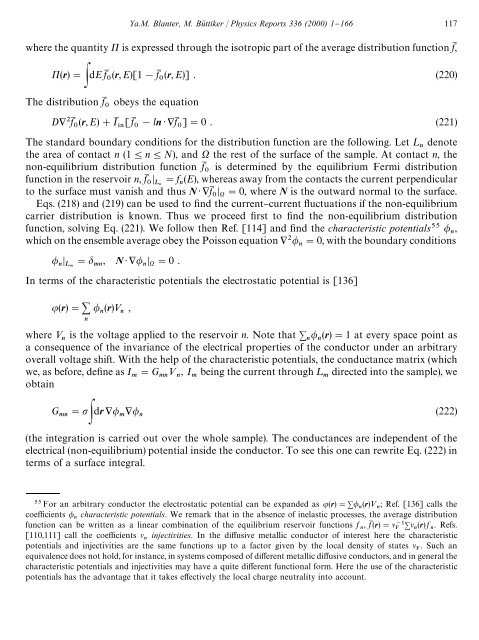shot noise in mesoscopic conductors - Low Temperature Laboratory
shot noise in mesoscopic conductors - Low Temperature Laboratory
shot noise in mesoscopic conductors - Low Temperature Laboratory
You also want an ePaper? Increase the reach of your titles
YUMPU automatically turns print PDFs into web optimized ePapers that Google loves.
where the quantity is expressed through the isotropic part of the average distribution function fM ,<br />
(r)" dEfM (r, E)[1!fM (r, E)] . (220)<br />
The distribution fM obeys the equation<br />
DfM (r, E)#IM [ fM !ln ) fM ]"0 . (221)<br />
The standard boundary conditions for the distribution function are the follow<strong>in</strong>g. Let ¸ denote<br />
the area of contact n (14n4N), and the rest of the surface of the sample. At contact n, the<br />
non-equilibrium distribution function fM is determ<strong>in</strong>ed by the equilibrium Fermi distribution<br />
function <strong>in</strong> the reservoir n, fM "f (E), whereas away from the contacts the current perpendicular<br />
to the surface must vanish and thus N ) fM "0, where N is the outward normal to the surface.<br />
Eqs. (218) and (219) can be used to "nd the current}current #uctuations if the non-equilibrium<br />
carrier distribution is known. Thus we proceed "rst to "nd the non-equilibrium distribution<br />
function, solv<strong>in</strong>g Eq. (221). We follow then Ref. [114] and "nd the characteristic potentials ,<br />
which on the ensemble average obey the Poisson equation "0, with the boundary conditions<br />
" , N ) "0 .<br />
In terms of the characteristic potentials the electrostatic potential is [136]<br />
(r)" (r)< ,<br />
<br />
<br />
where < is the voltage applied to the reservoir n. Note that (r)"1 at every space po<strong>in</strong>t as<br />
<br />
a consequence of the <strong>in</strong>variance of the electrical properties of the conductor under an arbitrary<br />
overall voltage shift. With the help of the characteristic potentials, the conductance matrix (which<br />
we, as before, de"ne as I "G < , I be<strong>in</strong>g the current through ¸ directed <strong>in</strong>to the sample), we<br />
<br />
obta<strong>in</strong><br />
G " dr <br />
Ya.M. Blanter, M. Bu( ttiker / Physics Reports 336 (2000) 1}166 117<br />
(the <strong>in</strong>tegration is carried out over the whole sample). The conductances are <strong>in</strong>dependent of the<br />
electrical (non-equilibrium) potential <strong>in</strong>side the conductor. To see this one can rewrite Eq. (222) <strong>in</strong><br />
terms of a surface <strong>in</strong>tegral.<br />
For an arbitrary conductor the electrostatic potential can be expanded as (r)" (r)< ; Ref. [136] calls the<br />
<br />
coe$cients characteristic potentials. We remark that <strong>in</strong> the absence of <strong>in</strong>elastic processes, the average distribution<br />
<br />
function can be written as a l<strong>in</strong>ear comb<strong>in</strong>ation of the equilibrium reservoir functions f , fM (r)"<br />
(r) f . Refs.<br />
<br />
[110,111] call the coe$cients <strong>in</strong>jectivities. In the di!usive metallic conductor of <strong>in</strong>terest here the characteristic<br />
<br />
potentials and <strong>in</strong>jectivities are the same functions up to a factor given by the local density of states . Such an<br />
<br />
equivalence does not hold, for <strong>in</strong>stance, <strong>in</strong> systems composed of di!erent metallic di!usive <strong>conductors</strong>, and <strong>in</strong> general the<br />
characteristic potentials and <strong>in</strong>jectivities may have a quite di!erent functional form. Here the use of the characteristic<br />
potentials has the advantage that it takes e!ectively the local charge neutrality <strong>in</strong>to account.<br />
(222)
















